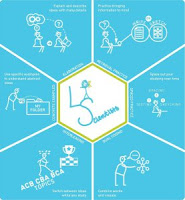6 Evidence based learning strategies

In a previous post I mentioned 3 Dimensions of studying effectively . One of those three dimensions is using effective learning strategies. All over the internet lists of effective studying can be found and I, too, have written several times about this topic (for example, see the above-mentioned post). Now, I have come across an interesting post by Megan Smith en Yana Weinstein in which they describe 6 evidence based strategies for learning some of which are relatively unknown both among teachers and students. Here are those 6 learning strategies:



